Virtual ICML Schedule Plan
TLDR for Attendees: There will be live poster sessions, and things to do happening at all hours of the day. Our schedule guarantees that every poster and invited talk and panel will happen at least once in a time friendly to your local time zone.
TLDR for Presenters: You choose what time windows you want to present your paper in, separated by ~11 hours, so that at least one is convenient for anyone in the world. We will ensure that your paper does not conflict with any plenary events, like invited talks.
Schedule Plan
The general conference will follow an "11 hour offset model" (see appendix for how we reached this) in which every presenter during the main conference (talks, tutorials, invited talks, test of time awardee, etc.) presents or discusses their work twice. Each of these two presentations will fall in a three hour window chosen by the authors (occupying only one of those three hours), with eleven hours separating the two three-hour windows: for instance, from 08:00-11:00 (in the presenter's local time zone) and again from 19:00-22:00 (again in in their local time zone, though not necessarily on the same day).
These windows ensure at least one falls in the 7:00-23:00 time range for all attendees in their own local time zone (see figure below). For example, consider a presenter in UTC+1, who presents at 09:00 and 20:00 in their local time. The former presentation will fall in a reasonable time window for attendees in UTC+0 (at 08:00) through UTC+12 (at 21:00). The latter presentation falls in a reasonable time range for attendees in UTC-11 (at 08:00) through UTC+2 (at 21:00). Thus, at least one presentation can be attended by anyone in the world at a reasonable time.
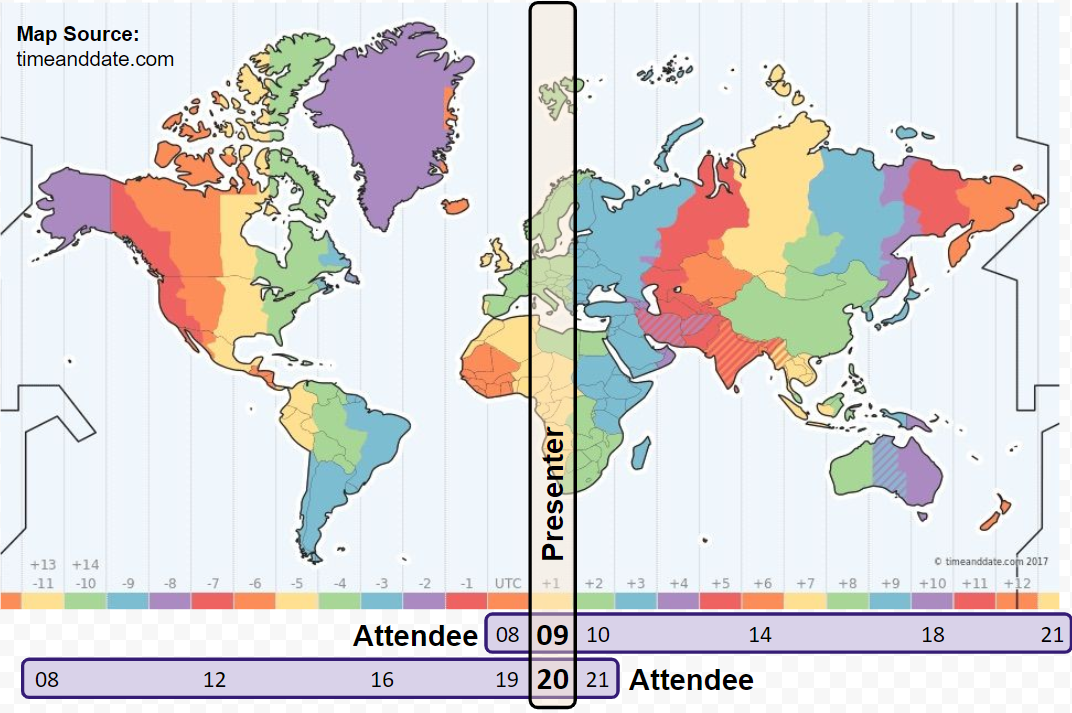
If the presenter is in some other time zone, then everything will shift left or right, but the same analysis holds.
What does this mean for each presentation type? (In the below, when we talk about "Days of the Week" (eg "Monday") this is always Monday AOE.)
Presented Papers
Authors will provide a video 15 minute video talk, and will also be available for two 45-minute-long blocks of time to present a virtual poster and answer questions (which they may do without visual aids). These "poster presentations" will all take place during the main part of the conference: Tuesday through Thursday. Presenters will be assigned two poster slots abiding by the "11 hour offset model" but perhaps not on the same day (e.g., possible 09:00 on Tuesday and 20:00 on Wednesday) to allow for scheduling of invited talks.
Videos will not be explicitly played back during the time of the conference; instead, the videos will be made available to attendees one week in advance of the conference, for them to watch whenever is convenient for them. Attendees are strongly encouraged to watch one or both videos before the poster presentation, and also to attend many posters -- interaction is one of the most important parts of a conference, and posters are a good way to engage with your fellow attendees!
Invited Talks and Panels
There are three invited talks, one for each day of the main conference (Tuesday, Wednesday, Thursday). Like presented papers, Invited talks will be available as pre-recorded videos (about 40 minutes in length), and available to attendees a few days before the conference. Although the video talks will be available ahead of the conference, to encourage interaction, the videos will also be simulcast during two (11-hour separated) time slots on each day. During the playback of these tasks, attendees may interact with the speaker via a chat interface and ask clarification questions.
After each playback of the talk concludes, there will be a moderated panel Q/A session with the speaker and one or two other guest panelists with overlapping but different expertise, about 60 minutes in length. During the first presentation of an invited talk, the panel will be live; for the second presentation, the speaker will still be available to answer questions, but a recording of the panel will be played back.
Test of Time Award
The test of time award will be presented similarly to invited talks, but with no panel discussion. In particular there will be one test of time award talk, which will be a pre-recorded video and available to attendees a few days before the conference begins. This will be played on Monday (the "tutorials day") at two time windows chosen by the awardees -- not overlapping with tutorials. Unlike the invited talks, instead of having a panel discussion there will be a short, live Q/A with the presenters after both presentations. The talk and discussion together will be 50 minutes long.
Tutorials
Tutorials will be presented on Monday. There are ten tutorials, each a total of two hours of pre-recorded videos, broken into four modules of 30 minutes each. Tutorial presentation videos will be available shortly before the conference, and will also be simulcast and their respective time slots. During those time slots, presenters will be available on chat to answer clarification questions on the fly, and then also answer more substantial questions in 15 minute breaks between each module.
Tutorials will similarly be assigned two time slots (each time slot is 3hr in total), determined in consultation with tutorial presenters so that (a) not all tutorials take place at the same time and (b) the presenters can attend those time slots.
Detailed Time Management
In order to facilitate scheduling, all times will be calculated in UTC+0. There will be 24 time slots throughout the day, each one hour long. Posters will occupy the first 45 minutes of each slot, with the last 15 minutes for short breaks, for participant interaction, and for attendees to visit the virtual expo hall and interact with sponsors.
On each main day of the conference (Tuesday through Thursday), the first thing scheduled will be the invited talk sessions. These will be a 120 minute session (taking two adjacent slots), occurring twice during that 24 hour period. Nothing else will be presented at the same time, thus "locking" four of the 24 time slots for that day. Once that invited talk is scheduled, posters will be scheduled around it, each poster getting two slots.
In order to facilitate this scheduling, poster presenters will be asked to select their preferred three hour blocks -- in many cases, those three hour blocks will not contain an invited talk, and posters can be spread into any of the slots in that block. However, in the case that the three hour block includes an invited talk, the poster will have to occur in the remaining time slot.
Process for Deciding on this Approach
We considered three models:
-
The ICLR model, where presentations happen around the clock, roughly balanced across time windows.
-
The ACM model, where all of the conference takes place in the late afternoon/early evening Central Europe time for a short duration of 4-5 hours.
-
A model where all presenters present twice, attempting to make sure everyone can attend at least one of those.
It turns out that 3 is possible, and has nice advantages over the other two (but with some downsides as well).
Analysis 1 (the ICLR model)
The main advantage to the ICLR model is that things are happening at all times. The main disadvantage is that some presenters have to present at very unfriendly times in their local time zone (eg middle of the night). However, everyone can attend at least one presentation of each paper (because every paper is presented twice), and papers are mostly uniformly spread across time, so there aren't any time slots that are much busier than others.
Analysis 2 (the ACM model)
Under the ACM model, all conference events happen in the same compressed time, which is suggested to be late afternoon in Western Europe. The time conversion looks as follows:
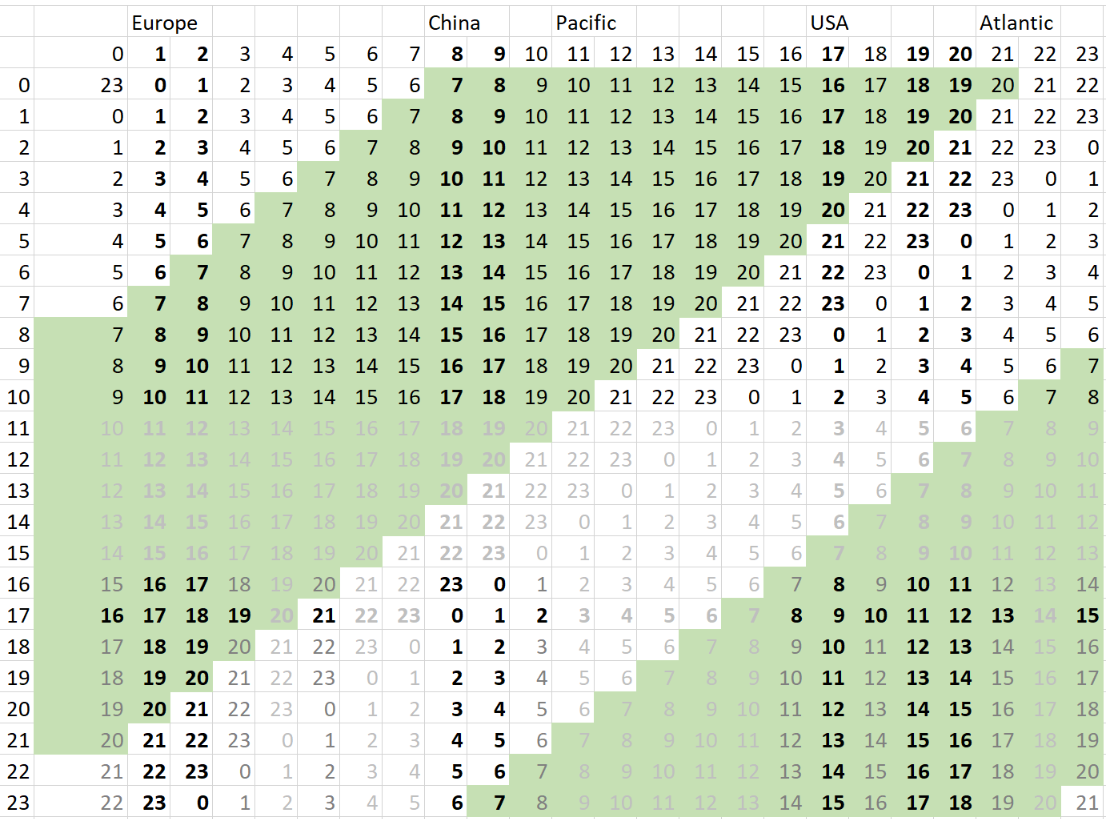
Here, the rows correspond to time in UTC+X (eg, +2 is Central Europe), and the columns correspond to other time zones (eg, +17 is west coast USA): you should think of rows as presenter times and columns as viewing times. The black, bold columns correspond to time zones where we have a large number of participants coming from (according to our earlier survey). The green cells are "reasonable" viewing time slots, where reasonable means between 7:00 and 21:00 local time for attendees (this was approximately the time ranges that people reported potential availability on that survey).
The basic take-away here is that the ACM proposal (presentations in rows 15-20 or so) works reasonably well for everyone except people in China, Japan, Australia, and other parts of East Asia, who would basically need to be awake at midnight to 4am to attend any parts of the conference. This is further made clear with our survey, where we asked participants when they could attend and converted all of these times to UTC+0:
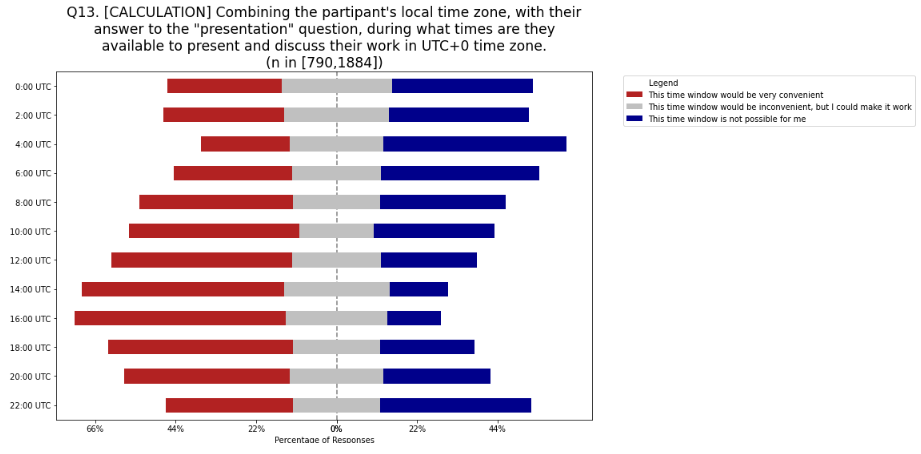
There is simply no time during which there aren't a substantial number of people who cannot attend (though the 14:00-18:00 range, as advised by ACM, is the best of the bad options).
The advantage to a model like this is that it's a fixed time for everyone (though that time differs depending on where you live), so it's easy to plan for and everything is kept together.
Analysis 3 (11hr Offset Model)
Finally, we consider what is to us a new model. Each presenter has to present twice: once between 8:00 and 11:00, and once between 19:00 and 22:00. (Or alternatively, any two three-hour blocks, with a gap of ~11hr between first and second presentation.) These particular choices are based on the results of the local-time version of the above survey question:
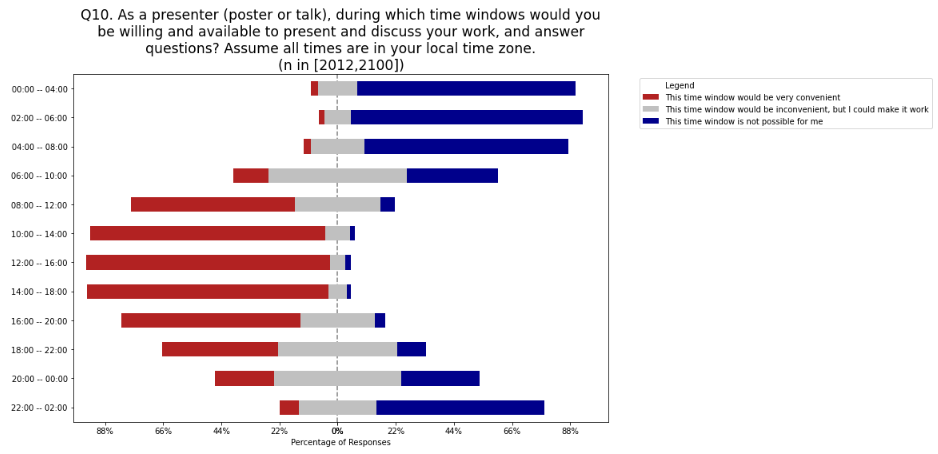
This is constructed so that no matter what time zone the presenter is in, and what time zone an attendee is in, that attendee can see at least one of the two presentations. This is depicted graphically here:
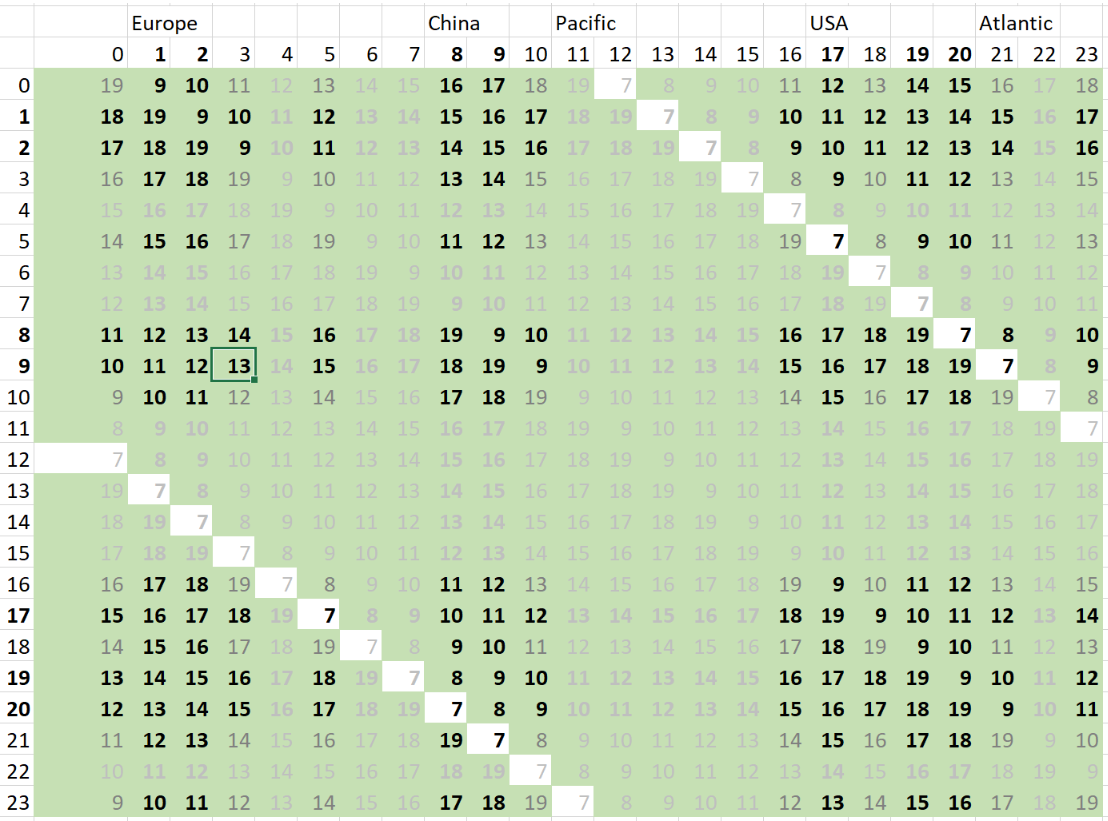
To read this, presenters time zones are rows and attendee time zones are columns, similar to the Analysis 2 figure previously. So, for instance:
-
Row 1, column 0 has the value "18". This means that an attendee in UTC+0 can see a talk by someone from time zone UTC+1 at 18:00 (in UTC+0) -- this would be the evening presentation by that presenter.
-
Row 1, column 2 has the value "9" -- this means that an attendee in UTC+2 can see the talk of a presenter from UTC+1 at 9a (in the attendees time zone of UTC+2). In this case, this would be the morning presentation of that presenter. (Of course they could alternatively go to the evening one, it would just be later for them. In this calculation, we assume everyone wants to go to the one closest to 14:00 their local time.)
Here, the only time slots that do not turn green correspond to some people having to attend talks at 7a, rather than the 8a preferred threshold. This happens, for instance, for row=UTC+8, column=UTC+20 (e.g., Beijing presenter and Montréal attendee), where the attendee would have to attend at 7a. Limited to the regions with many attendees, this is actually the only bad case.
As an intuitive "proof" of this model, suppose there is an event just outside your comfort window. In the first case, say it is slightly too early: 07:00-08:00 in your local time zone. The 11hr model means it will also be presented either 11 hr earlier (20:00-21:00 in your local time zone) or 11 hr later (18:00-21:00 in your local time zone), both of which fall in reasonable times. In the second case, say it is slightly too late: 22:00-23:00 in your time zone. It would then also be presented either 11 hr earlier (11:00-12:00) or 11 hr later (09:00-10:00), both of which again fall in reasonable times.
A downside to this model is that talks will not be spread uniformly over time. In particular, in our survey, about 25% of attendees are in UTC+1 (x-axis is time zone as a positive offset from UTC, rounded to the nearest hour):
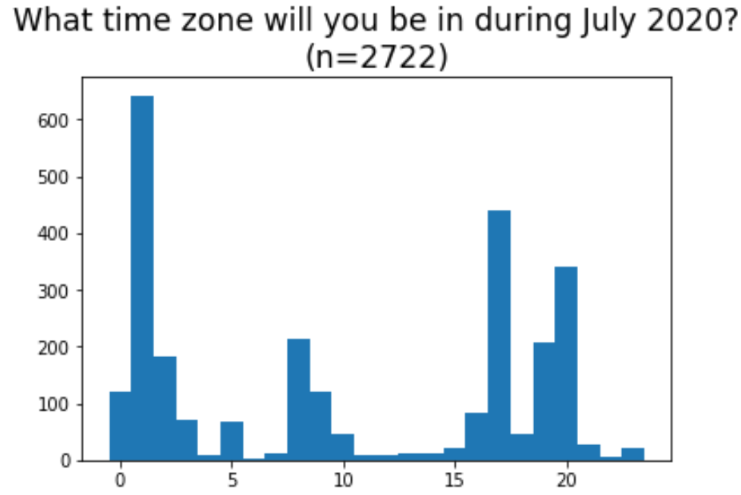
If we assume 1000 accepted papers, with the highest density at UTC+1 (which is 25% in our survey), and spread across three days, then 80 papers will be presented in the same 3 hours time window. If we assume we split each into two poster sessions, that's 40 papers per session, which is hopefully not too high. We could also ask people in heavy time zones to shift slightly (eg ask UTC+1 presenters to volunteer to move to UTC+0 or UTC+2). This will be most challenging for poster presenters who overlap with an invited talk because they cannot be split. To mitigate this, we will allow poster presentations to happen on different days, so long as they are still 11hr apart.
Another potential downside is that authors in dense time zones may have a hard time attending many other presentations during their own time slot. We can mitigate this to some degree through shuffling: half of presenters who get the first hour in the morning can get the second hour in the evening, and so on.